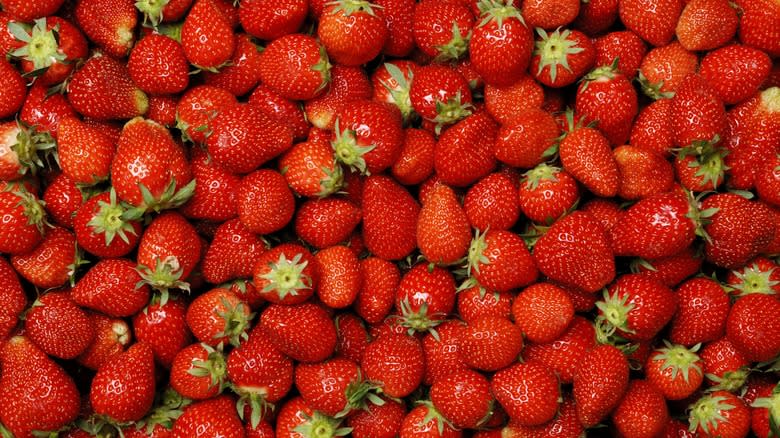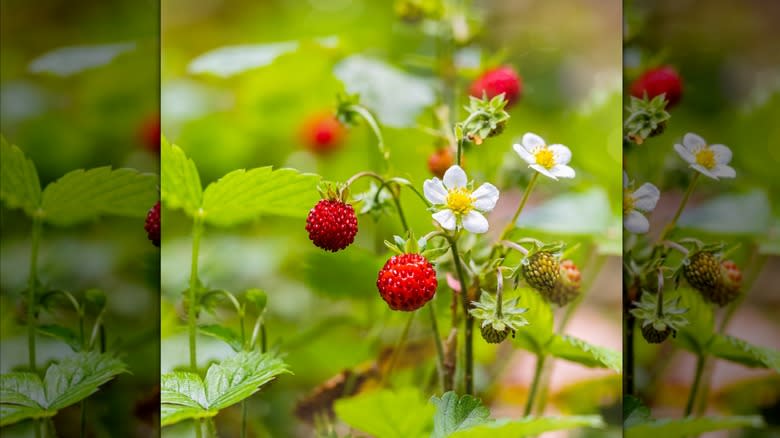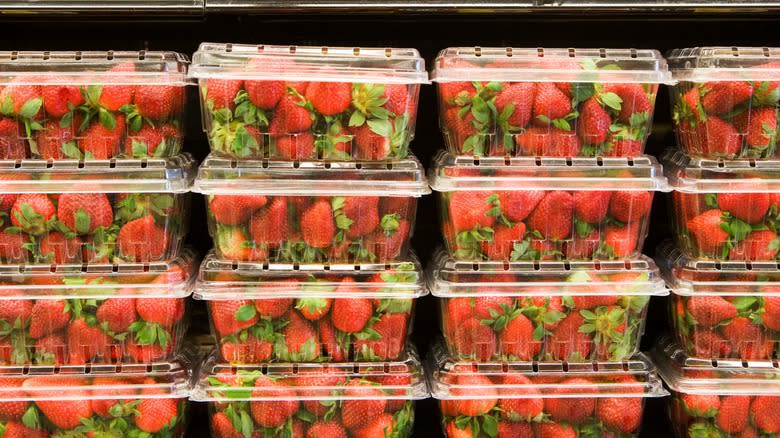Wild Vs Store-Bought Strawberries: What's The Difference?

There's a reason pick-your-own apple orchards and strawberry patches are so popular: Freshly picked fruit in the wild just tends to taste better. We imagine that the taste of that red apple still hanging on the tree is much juicier and crunchier than what we find at the grocery store and that the strawberries are more flavorful and sweet. Whether the store-bought variety is inferior to the wild kind is up to your taste, but there are differences between the two that account for their varying flavor, size, and color.
The first thing most people notice when picking wild strawberries is that they're tiny compared to those at the grocery store. We often believe that bigger is better, but one bite will prove that theory doesn't apply to strawberries. They may be small, but wild strawberries taste much sweeter than store-bought. According to the Royal Society of Chemistry, there's a scientific reason behind it. Wild strawberries "have higher aroma intensities and significantly richer [flavors] because they contain greater quantities of odorous molecules, including some extra ones."
Some may wonder why we can't just grow strawberries with more significant amounts of aroma compounds for grocery stores, but it's not that simple. The strawberries sold in grocery stores are bred to last longer on the shelves, ship better, and resist disease better than their wild cousins. While this is positive for consumers, it makes the genetic pool smaller -- the cross-breeding results in less flavorful strawberries.
Read more: 7 Nuts You Should Be Eating And 7 You Shouldn't
There Are Three Wild Strawberry Species

Wild strawberry plants can grow up to six inches high, with white flowers dotting the leaves. They are a member of the Rose family, within which you'll find three wild strawberry species: Fragaria virginiana, Fragaria vesca, and Fragaria chiloensis. The variations within these three species are alpine (woodland or European), beach (coastal, Fraises des Bois, or Chilean), and Virginia or mountain. However, many cultivated, store-bought varieties share the same roots as the wild strawberries.
Wild strawberries are self-seeders that don't need much attention, tend to grow just about anywhere, and spread fast. They can be found in forests, fields, mountains, and even unlikely places like wall cracks. But for amateurs or newbies, it's easy to make the common strawberry-picking mistake of misidentifying mock strawberries for the real thing. While they look similar, fake strawberries have yellow flowers and a crunchy, bland taste.
Wild strawberries are delicious, red all the way through, and intensely sweet, but it might be difficult to fill a bucket with them due to their tiny size. It can take an hour to gather a cup's worth. They're perfect to snack on straight from the plant and they're great in salads or as toppings for dessert. To guarantee they last longer than a day, put them in a cooler immediately after picking.
Grocery Store Strawberries Are Bigger But Not Always Better

All strawberries you find in the grocery store fall under three types: June-bearing, Everbearing, and Day-neutral. June-bearing are some of the largest and most common varieties. Everbearing strawberries are smaller and produce a harvest in spring and late summer/fall, while day-neutral produce between July and October. Identifying which variety you're buying is complicated, as most brands don't tell you. One of the most prevalent, Driscoll's, crossbreeds its berries and even created a Tropical Bliss strawberry in 2022. Driscoll's isn't forthcoming about what kinds it currently breeds.
Store-bought strawberries tend to be larger, less flavorful, and are often white inside. This is partly because they were bred to be bigger and sturdier at the sacrifice of sweetness. They're also frequently picked and shipped before they're fully ripe, and sometimes berries will turn red before the flavor has developed. With store-bought berries, the crucial part is choosing the best strawberries. Look for smaller berries because they'll be sweeter, and try to find some that are fully red and dry. Wet strawberries have already started to turn, and white or green near the stem means a less-flavorful berry.
All strawberries contain flavonoids that can protect you from heart disease and cancer and lower your cholesterol; they're high in fiber and potassium, which help keep your heart and bones healthy and lower blood pressure; and they contain folate, which helps support cell growth and tissue function, fight inflammation, and boost the immune system.
Read the original article on Mashed.

